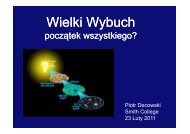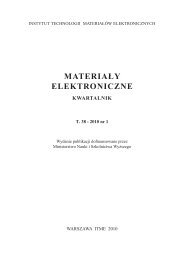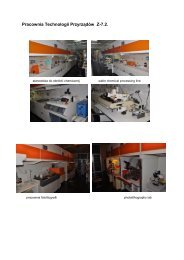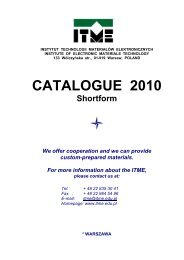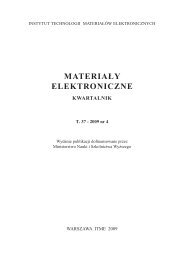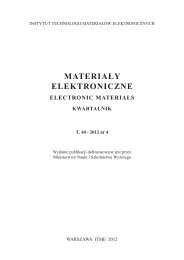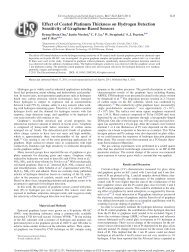MATERIAÅY ELEKTRONICZNE - ITME
MATERIAÅY ELEKTRONICZNE - ITME
MATERIAÅY ELEKTRONICZNE - ITME
Create successful ePaper yourself
Turn your PDF publications into a flip-book with our unique Google optimized e-Paper software.
P. Kamiński, M. Kozubal, J.D. Caldwell, ...<br />
Fig. 4. The values of the thermal emission activation<br />
energy E a<br />
and apparent electron capture cross-section<br />
σ n<br />
, calculated from the slope and intercept of each<br />
line, are listed in Table I.<br />
Table I. Summary of activation energies and capture<br />
cross-sections for deep electron traps detected the 4H-<br />
SiC epilayers A and B before and after 300-keV electron<br />
irradiation.<br />
T a b e l a I .<br />
Fig. 3. DLTS spectra typical of nitrogen-doped epilayers<br />
A (left) and B (right) after irradiation with a dose of<br />
1.0×10 17 cm -2 of 300-keV electrons.<br />
Rys. 3. Widma DLTS typowe dla warstw epitaksjalnych<br />
z grupy A (strona lewa) oraz z grupy B (strona prawa) po<br />
napromieniowaniu dawką elektronów o energii 300 keV,<br />
równą 1,0 x 10 17 cm -3 .<br />
Fig. 4. Arrhenius plots for deep electron traps detected<br />
in as-irradiated, nitrogen-doped epilayers A and B of<br />
4H-SiC.<br />
Rys. 4. Wykresy Arrheniusa dla pułapek elektronowych<br />
wykrytych w domieszkowanych azotem warstwach epitaksjalnych<br />
4H-SiC z grupy A oraz z grupy B.<br />
Trap<br />
label<br />
Activation<br />
energy<br />
E a<br />
[eV]<br />
Capture<br />
cross-section<br />
σ n<br />
[cm 2 ]<br />
Epilayer<br />
Z 1/2<br />
0.63±0.05 1.3×10 -14 A, B<br />
TI2 0.71±0.05 4.2×10 -15 B<br />
TI3 0.78±0.05 4.1×10 -16 A, B<br />
TI4 1.04±0.05 4.8×0 -15 A, B<br />
Remarks<br />
observed in as-<br />
-grown and irradiated<br />
material,<br />
V Si<br />
V C<br />
irradiation<br />
induced, S2 in<br />
Ref. 24, N i<br />
(C i<br />
) 2<br />
irradiation induced,<br />
EH4 in<br />
Ref. 7, V C<br />
(2-/-)<br />
irradiation induced,<br />
EH5 in<br />
Ref. 7, V C<br />
(-/0)<br />
irradiation induced,<br />
EH6 in<br />
TI5 1.33±0.05 1.3×10 -13 A, B<br />
Ref. 19, (C i<br />
) 2<br />
Fig. 5 shows the comparison of the Z 1/2<br />
center<br />
concentrations after the irradiation, as well as the<br />
concentrations of irradiation-induced traps TI2,<br />
TI3, TI4 and TI5 in the epilayers A and B. It should<br />
be added that the Z 1/2<br />
center concentrations were calculated<br />
from the capacitance changes observed in the<br />
temperature range of 300 – 350 K. The results indicate<br />
that the Z 1/2<br />
center concentrations, induced in the<br />
epilayers A and B by 300-keV electron irradiation,<br />
are 8.25 × 10 14 and 3.17 × 10 15 cm -3 , respectively. It<br />
is interesting to note that according to the results of<br />
Danno and Kimoto [19], for 4H-SiC epilayers with<br />
N D<br />
– N A<br />
ranging from 8.0 × 10 14 to 1.6 × 10 16 cm -3<br />
before the irradiation, the Z 1/2<br />
center concentration<br />
induced by the irradiation with 300-keV electrons is<br />
~1 × 10 15 cm -3 . The results shown in Fig. 5 indicate<br />
that the Z 1/2<br />
center is the predominant electron trap<br />
induced in the epilayers A and B by the electron<br />
irradiation at 300 keV and a dose of 1 × 10 17 cm -2 .<br />
Compared to as-grown material, the increase in the<br />
31




